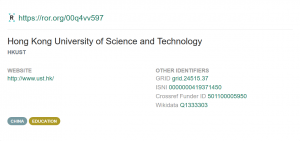If you use a database to find papers by HKUST researchers, do you key in “HKUST” or spell it out in full? Which way do you think is more effective to find what you want? What if you are looking for HKU papers?
Accurately and uniquely identifying affiliations of research work in the academic publishing has been an issue for a long time. Just like researchers’ personal names, university names can have multiple variants. You may easily find a few variations of HKUST if you sample a dozen journal papers. To address this problem, a system of persistent identifiers (PID) can help.
Many of us are familiar with DOIs, digitial object identifiers, that help us easily, uniquely locate research outputs. Almost all researchers at HKUST have their ORCID iDs, the identifiers that differentiate the John Chan in chemistry from the John Chan in economics. While DOIs define output of research (the “what”), ORCID iDs follow people of research (the “who”), how about the affiliated organizations (the “where”)?
In 2019, Research Organization Registry — ROR, launched as the first open, community-led system for research organizations. Currently it holds over 90,000 records in the registry, each record includes a unique ROR IDs and associated metadata. This is HKUST’s entry (retrieved Sept 3, 2020):

ROR was built upon another organization identifier system GRID, which was curated by the company Digital Science. You can find HKUST in GRID. Before ROR, Ringgold identifier for organizations was also widely adopted. However, the open nature of ROR means that the data will remain open and free for all.
PID is an important infrastructure for scholarly communications. A successful adoption of organization identifiers like ROR across the system will make things easier for everyone. We can imagine how ROR and ORCID together can benefit researchers and institutions in various tasks, such as submitting papers to journals, managing project data, organizing researchers’ profiles, applying for funding, and managing institutional output for evaluation.
More about ROR
— By Gabi Wong, Library
Views: 861
Go Back to page Top
- Category:
- Academic Publishing
published October 7, 2020
last modified March 11, 2022


